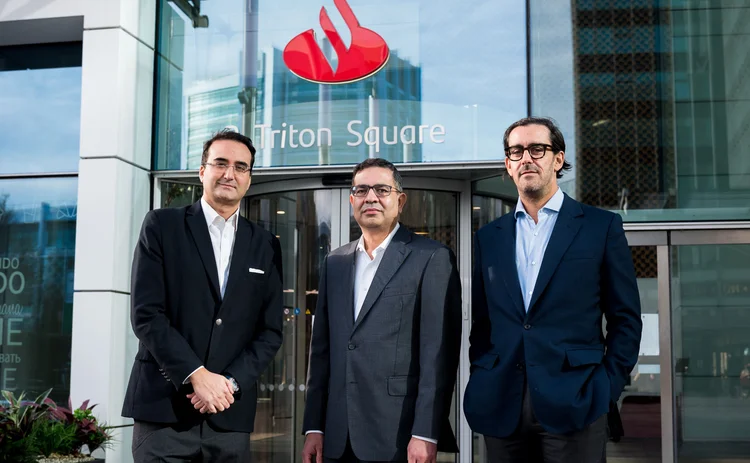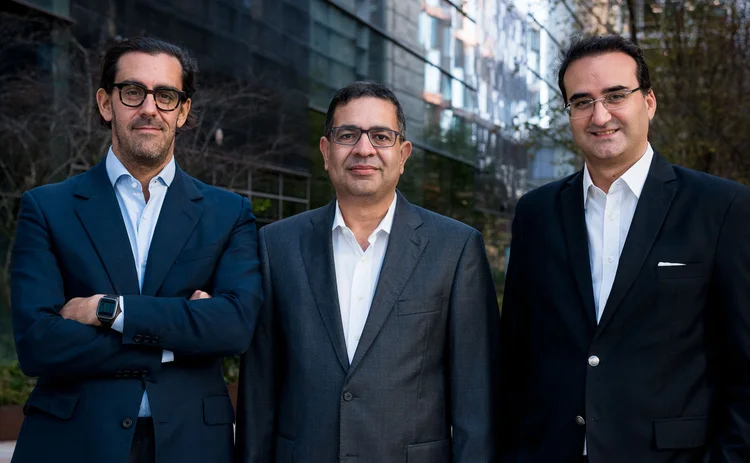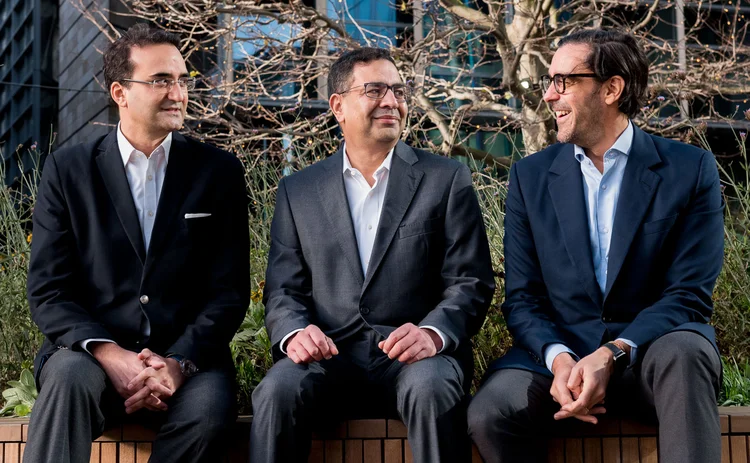
Risk solutions house of the year: Santander Corporate & Investment Banking
Risk Awards 2025: Bank-wide co-ordination spurs creative solutions including ‘umbrella’ deal contingent swap

Deal contingent hedging has become a ubiquitous offering, allowing clients to lock in interest rates or foreign exchange risk on a project or acquisition before it completes. Banks providing these hedges must gauge the likelihood of the deal being scuppered – a scenario that can create mismatches and expose them to losses.
This year, Santander’s Corporate & Investment Bank navigated a range of complex contingencies, from second-guessing an export credit agency’s backing of a French telco loan, to weighing the odds of a complex cross-border bid for a Polish gaming operator. The bank also got creative with an ‘umbrella’ hedge for a wind farm financing, which diversifies deal contingent risk across individual projects.
Krishna Murali, global head of distribution for Santander CIB says this market has been rapidly changing, with contingencies becoming increasingly intricate.
“Historically it was based on M&A, where antitrust, foreign direct investment and shareholder consents were the condition precedents to complete. Increasingly we have seen financing as the take-out for a DC,” says Murali.
“Clients and sponsors are increasingly getting sophisticated in wanting to hedge macro variables: we’ve managed to deliver solutions to them.”
The key thing with Santander is we find them very well connected across their bank
A large asset manager client
Here, Murali sees a competitive edge in Santander’s smaller investment banking footprint, which facilitates cross-firm co-operation compared to large rivals that tend to operate in vertical product silos.
“We are able to combine advisory, underwriting and the risk management piece much closer together to find solutions for clients, rather than only pigeonholing them into something that works for us,” Murali says.
“It’s a two-way street where we find a solution that works for the client and jointly makes sense for us.”
Clients also cite this connectivity as a core strength.
“The key thing with Santander is we find them very well connected across their bank,” says a large asset manager client who has completed numerous deal contingent trades with Santander.
“In certain scenarios, I’ve been on phone calls with them in the heat of a transaction, when there’s tons of different work streams going on, and they all know more than I do, because they’ve had a conversation with their syndicate team or their lending colleagues or their M&A advisers in advance
The client adds this is done on a ‘need-to-know’ basis “to get the best outcome and keep things smooth and moving forwards”.
Under my umbrella
Santander’s ingenuity was on display when it helped a renewable energy provider expand its operations across Europe.
A Swiss infrastructure asset manager was buying a minority stake in a large French wind farm business to fund growth. Santander co-financed the €400 million deal and provided a slew of credit on top to finance 14 new wind farms.
Project Roma, as the deal became known, was no vanilla project financing transaction.
To lock in financing rates, the sponsor opted for a forward-starting swap, contingent on projects reaching the ready-to-build stage, when financing is released. These contingencies ranged from common antitrust approvals to more esoteric risks such as environmental permits, planning permission and finalising the deal with a building contractor.
As sole hedging bank for the deal contingent, Santander approached the deal with the assumption that not all of the 14 projects would reach this pivotal point.

Rather than issuing a series of individual deal contingent trades based on the probability of each project reaching the critical stage, Santander opted for an innovative ‘umbrella’ approach – a first for the lender.
This saw the bank structure a single deal continent swaption collar for the full notional value of wind farm sites it believed were closest to being ready. A haircut was applied to those that had a lower chance of reaching this stage.
As each wind farm project ticked the necessary approvals to move forward, the relevant notional associated with the individual project was converted into a swap, which was structured to the profile of the loan in terms of duration and risk.
Matías Mayora, global head of corporate and financial sponsor structuring at Santander CIB describes the structure as a single deal contingent trade that morphs into individual vanilla swaps “as each project comes into a ready-to-build condition”.
The total notional value of deal contingent hedging, including a vanilla portion, was €175 million – lower than the sum of the parts given the assumption some would take much longer to reach the ready-to-build stage.
“There were a few sites where there were very long contingency windows, where we applied a higher haircut,” says Mayora.
Having the completion risk of multiple projects built into a single deal contingent brings diversification benefits, says Christian Banna, head of the risk solutions group UK at Santander CIB.
“I think the diversification play arguably makes it less risky,” says Banna.
The bank is in discussions with clients in the US and Spain about rolling out the approach to other portfolios of energy assets, including gas pipelines and solar farms.
Phone home
The close co-ordination Murali speaks of was apparent when an Asian electronics firm exported hundreds of thousands of mobile phones to Bouygues Telecom in France.
The deal relied on a $350 million loan to Bouygues – part of a $2 billion credit line between Bouygues and Santander’s Global Transaction Banking (GTB) arm. Against a volatile rates backdrop, Bouygues was keen to derisk the fixed rate early in the process, though internal policies prevented it from entering into vanilla hedges.
Santander responded to the challenge by offering the first facility combined with a deal contingent hedge to an export credit agency, which provided backing for the loan.
This was done via a forward starting pay-fix receive-floating swap that would be contingent on the ECA approval unlocking the loan from Santander.
Once the ECA agreed to underwrite the export trade, the swap was closed out and Santander provided a fixed rate loan at the previously agreed rate. If the ECA had decided not to underwrite the credit insurance, the swap would have been cancelled, with Santander taking a loss if the derivative was out of the money, but a gain if the swap was in the money.
The overall window of contingency risk was around four months.
These government backed agencies commonly provide lending support to export activities, yet it is the first time Santander has structured a deal contingent based around ECA approval risk. Second-guessing the credit committee of a government-backed lender was a gamble the bank was prepared to take.
Matias Mayora, global head of corporate and financial sponsor structuring at Santander CIB leaned on colleagues in the ECA finance team to help gauge the risk, while a deep knowledge of the export credit market gave the bank comfort that the ECA would ultimately back the deal.
The ability to move quickly helped Santander clinch these kinds of deals, according to Mayora. He says colleagues in the GTB division and the risk solutions team worked together to “review all the transactions that potentially can lead to a risk management situation, because it is crucial to come in early and to suggest to the client the best solution in a scenario where volatility in interest rates and FX is quite high.”
The client was impressed with the outcome. “This transaction illustrates our shared commitment to delivering cutting-edge financial solutions and achieving excellence,” says a Bouygues spokesperson.
Place your bets
LSEG-listed Entain Group is best known as the owner of UK bookmaker Ladbrokes and US online gaming website BetMGM. In June 2023, Entain agreed to buy Warsaw-listed sports betting company STS Gaming for £750 million.
As a FTSE-100 company, Entain has plenty of banking firepower at its fingertips, with joint corporate brokers Bank of America and Morgan Stanley just a phone call away at any time.
Santander joined the two US banks as a financial adviser on a £600 million ($760 million) rights issue, which funded the Polish acquisition.
Polish rules require a guarantee or letter of credit from a highly rated bank for the entire funds required to close an acquisition – in this case, 3.9 billion zloty.
As the third largest bank in Poland, Santander was sole provider of the guarantee, and was able to produce a letter of credit for the full amount through its global transaction banking division.
That still left a glaring currency mismatch between the sterling rights issue proceeds and the zloty needed to finalise the acquisition.

Entain immediately converted rights proceeds into euros – the group’s operating currency on the continent – leaving the company exposed to any strengthening of the zloty versus the euro for the closing period.
Entain also couldn’t be certain the deal would be approved. This called for a contingent EURPLN FX forward, which would represent a ‘bridge’ between the sterling rights issue and the zloty guarantee backing the deal. In contrast with most deal contingent forwards, Entain didn’t know how many shareholders would vote in favour of the acquisition at the time the deal was pulled together.
“We worked closely with them to put in place an FX forward in a deal contingent format covering a portion of the risk related to irrevocable undertakings from the seller shareholders, and particular care was given to the overall structure as any FX hedging needed to interact with the terms of the guarantee,” says Santander’s Banna.
The zloty forward had a ‘window feature’ and a ‘predetermined price’, which meant Entain knew the exact FX rate for every possible closing date of the transaction, providing more visibility for the acquirer to plan and fund its closing steps.
The raw ingredients here – a sterling equity raise and a deal contingent EURPLN forward – are something “a lot of banks can do”, Banna acknowledges.
The novelty lies in co-ordination across multiple parts of the bank to support a complex deal to completion – from equity capital markets, to leveraged finance, FX and transaction banking.
“The thing that was different here was who worked on this deal: we had our coverage bankers leveraged finance team, our ECM team, who were a co-manager on the rights issue, and our transactional banking team, who set up the guarantee,” says Banna.
“We like the deals that require us to be agile and join the dots across our internal teams and regions to help deliver the right solutions for our client. This was a great example of that.”
Charlie Sutters, group corporate finance director at Entain says Santander “really did come through in a very big way, because it was a very complicated transaction”.
“It really was a very nice, joined up, whole bank approach.”
Only users who have a paid subscription or are part of a corporate subscription are able to print or copy content.
To access these options, along with all other subscription benefits, please contact info@risk.net or view our subscription options here: http://subscriptions.risk.net/subscribe
You are currently unable to print this content. Please contact info@risk.net to find out more.
You are currently unable to copy this content. Please contact info@risk.net to find out more.
Copyright Infopro Digital Limited. All rights reserved.
As outlined in our terms and conditions, https://www.infopro-digital.com/terms-and-conditions/subscriptions/ (point 2.4), printing is limited to a single copy.
If you would like to purchase additional rights please email info@risk.net
Copyright Infopro Digital Limited. All rights reserved.
You may share this content using our article tools. As outlined in our terms and conditions, https://www.infopro-digital.com/terms-and-conditions/subscriptions/ (clause 2.4), an Authorised User may only make one copy of the materials for their own personal use. You must also comply with the restrictions in clause 2.5.
If you would like to purchase additional rights please email info@risk.net
More on Awards
Clearing house of the year: LCH
Risk Awards 2025: LCH outshines rivals in its commitment to innovation and co-operation with clearing members
Best use of machine learning/AI: CompatibL
CompatibL’s groundbreaking use of LLMs for automated trade entry earned the Best use of machine learning/AI award at the 2025 Risk Markets Technology Awards, redefining speed and reliability in what-if analytics
Markets Technology Awards 2025 winners’ review
Vendors jockeying for position in this year’s MTAs, as banks and regulators take aim at counterparty blind spots
Equity derivatives house of the year: Bank of America
Risk Awards 2025: Bank gains plaudits – and profits – with enhanced product range, including new variants of short-vol structures and equity dispersion
Law firm of the year: Linklaters
Risk Awards 2025: Law firm’s work helped buttress markets for credit derivatives, clearing and digital assets
Derivatives house of the year: UBS
Risk Awards 2025: Mega-merger expected to add $1 billion to markets revenues, via 30 integration projects
Interest rate derivatives house of the year: JP Morgan
Risk Awards 2025: Steepener hedges and Spire novations helped clients navigate shifting rates regime
Currency derivatives house of the year: UBS
Risk Awards 2025: Access to wealth management client base helped Swiss bank to recycle volatility and provide accurate pricing for a range of FX structures







